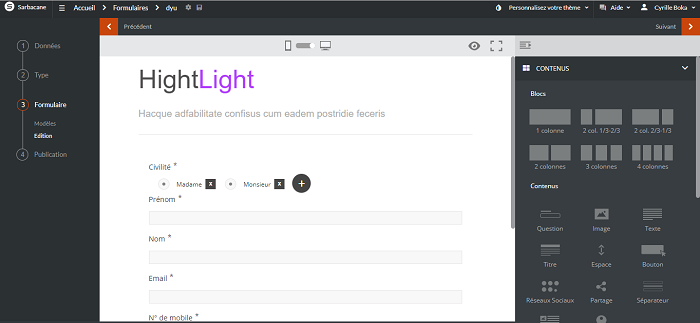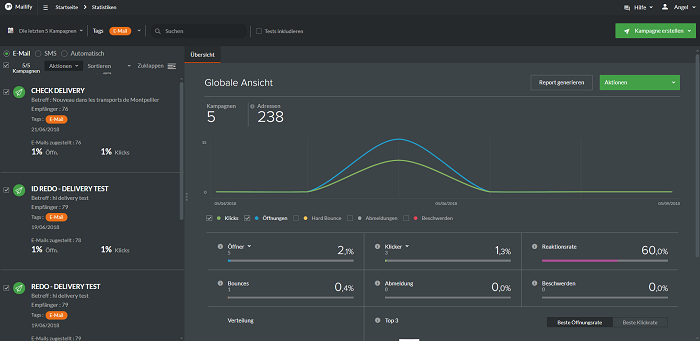
Some online stores believe that email software requires too much financial and human effort for too little return. This is not the case! Newsletter is one of the most used marketing methods and very effective in terms of ROI (Return on Investment), sometimes up to 3800%, or up to 38€ profit per invested Euro!
In addition, 771 billion newsletters were sent last year, an increase of almost 150 billion over the previous year.
With the right email marketing software, the effort required to create an email campaign is minimal. Many applications offer a range of ready-to-use templates that allow you to create newsletters with just a few clicks.
How to use email marketing software correctly and achieve a good return on investment?
1. Create a form
Before a campaign is created, it is necessary to have a suitable contact list. What is the best way to achieve this?
Several methods are possible. The most creative solutions are often the most effective! In the past, contests, discounts, white papers, e-books etc… have been a solid method to quickly build a reasonable contact list.
We recommend that you make a thorough investigation before you consider using any of the above methods to generate new contacts.
For example, if you have a new subscriber, ask them to fill out a form with their contact information. There are different types of forms that you can use:
- Dedicated page / landing page
- Pop-up
- Block to be integrated

Choose the method that suits you – or several! With the right email marketing software, this is possible in just a few steps. You can drag and drop different fields into your form and quickly customize it.

2. Importing your contact list with an email marketing program
If you used an all-in-one marketing solution to create your form, the contacts you receive are automatically transferred to one of your previously selected contact lists.
If you use your own form or an external form, you must specify the collected contacts in your application. This is usually done effortlessly by simply uploading an Excel, csv or txt file. The different columns are automatically recognized and you will be asked whether the selection or assignment of the columns was made correctly.

Make sure that you only use data for which you have the subscriber’s consent, otherwise you could face penalties.
Create your blacklist, which contains all users who have unsubscribed from your newsletter.

With good email marketing software, an unsubscribe link that is inserted into each of your emails will automatically create a blacklist. We will come back to this topic later.
Segment your database as much as possible! With good segmentation you can, for example, target specific interest groups and thus significantly increase the success of your email marketing campaigns.
3. Create an email marketing campaign
Contact lists were successfully imported and created. Now it is time to create your first email marketing campaign. Two options are possible.
Either you create a regular email marketing campaign that you manually send to your contacts during your most important times, or you create an automated campaign.
An automated campaign is triggered by various actions. We all know the automatic welcome email we receive when we subscribe to a newsletter, contact a website or for example on our birthday.

These contact moments can be planned with the help of an automated campaign. In this way you can continue to draw attention to yourself with small actions at ever shorter intervals from the day of registration. This concatenation of emails in certain intervals is called workflow.
Other triggers can be special data, e.g. the birthday of a customer or the date of registration in the database (subscription date).
You can define the profile update as another reason for sending an automatic email. Let your creativity run free!
4. Create a newsletter – EmailBuilder
Professional newsletter tools usually use an EmailBuilder, with which you can easily create your templates. You can choose from a number of ready-to-use templates and adapt them to your corporate design.

Depending on the chosen email software there can be big differences!
- Make sure that you only use royalty-free images. Some applications provide a database of royalty-free images directly in the EmailBuilder.
- The main goal that you should keep in mind is to constantly improve your statistics, such as the opening rate of newsletters or the click rate. A good starting point is the personalization of your newsletter. Create an exciting topic and set the recipient’s name as a variable. The e-mail software will automatically put the contact name in the subject line, which can increase the opening rate a lot!
- One rule to follow when creating an email-marketing-campaign is to define two CTAs (Call to Action Buttons) by integrating them at strategic points: one button at the beginning before the waterline and one button at the end.
- Also pay attention to the text/image ratio. It is recommended to have a ratio of 60:40 or 70:30 in favour of the text. Inserting too many images in emails may result in a longer loading time for the recipient. In addition, email providers misinterpret the excess images, so you run the risk of appearing as spam.
- Select relevant content to highlight. Use special events such as the World Cup or Olympic Games to create e-mailings about current events. This allows you to connect with your recipients and thus influence the level of awareness and possibly your sales. Email campaigns based on national/international events are becoming increasingly successful!
- An unsubscribe link is mandatory! Always give your recipients the opportunity to unsubscribe by clicking on an unsubscribe link. It is often advisable to include this contact in a blacklist. Some e-mailing solutions provide you with data about unsubscribing your contacts, such as: after which email campaign did the recipient unsubscribe or how long has he or she been on the list?
5. Sending the newsletter
Once your contact list is collected, your newsletter created and personalized, it’s time to send it!
Many email providers want to protect their customers from spam. For this reason, many mass mailings are sometimes automatically placed in a spam folder. Once an email gets into the spam folder and was not expected by the recipient, the probability that the email will be opened is close to zero.
Some email programs allow an anti-spam test before sending the newsletter. Also send your newsletter to your colleagues, friends, family and your own email account to test it. This way you can check again for display errors and see if your newsletter was received.
For such tests it is useful to try several different email service providers.
When sending your newsletter, also consider the background of your target persons. If your main target is students, you should avoid sending email campaigns on Saturdays and Sundays.
For people who work for B2B, it is recommended to send your emails during working hours, as most emails are read during this time.
If you want your customers to buy your product or service quickly, you should focus your email campaigns on the beginning of the month.
6. Evaluate statistics using email marketing software
Try to optimize your newsletter at any time. A good email marketing software provides you with a number of statistics that allow a detailed analysis of opening rates, click rates, unsubscribe rates, etc..

By analyzing email marketing statistics, you can collect geolocation data that you can use, for example, to test a regional newsletter.
Sending e-mails is easy and efficient, and the creation is done with a few clicks. By sending emails you can increase your sales considerably and build a close and lasting relationship with your customers.
Be creative and try to create unique email campaigns. Good luck!
You will find more details, video tutorials on Mailify and many additional ideas on how to turn prospects into loyal customers and create added value for yourself.
Cyrille Boka, Content Manager Junior, Mailify
